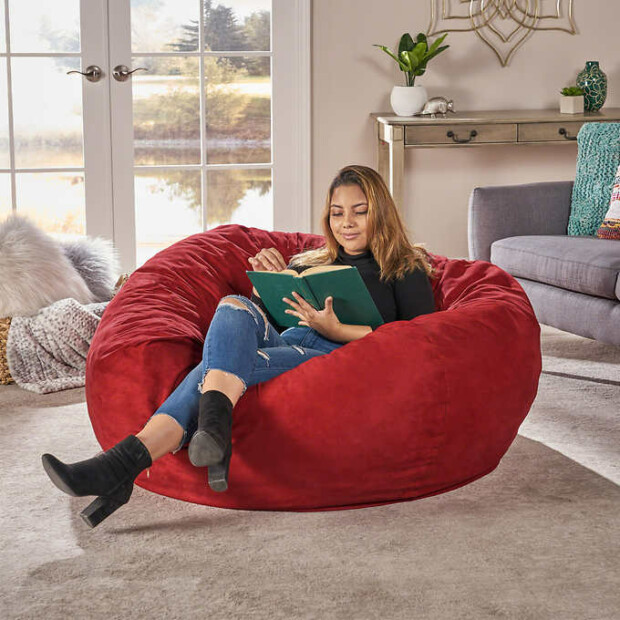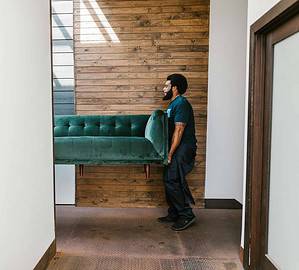Bean bag chairs have come a long way in terms of comfort and functionality. They make for rather fun and ergonomic seats anywhere, anytime!
It doesn’t take rocket science to keep them functional – all you need to do is replace or refill the beans. The key factor that will determine the comfort you get from these refreshing chairs is the filling being used.
And just because you had a particular type of filling before, doesn’t mean you can’t choose a different kind now.
Whatever be the case, choosing the best filling can become rather confusing. And for this reason, we have come up with a detailed list of the different fillings, complete with their characteristics, if you are looking for the best bean bag chairs, you can find them here.
With all said and done, let’s dive in!

How To Choose The Best Filling For Your Bean Bag Chair
Choosing the best filling for your bean bag chair involves just one major step – knowing the material of the beans. Since different materials have different characteristics, it’s important to understand them, so that you can select the ideal filling according to your needs.
In the following sections, we discuss the most commonly used fillings for bean bag chairs.
1.Expanded Polystyrene Beads
Most bean bag chairs, irrespective of their size and lining, are filled with beads made from expanded polystyrene or EPS. It’s a manmade, hard-celled plastic that closely resembles styrofoam (made from extruded polystyrene) in its structure and qualities. Not only are EPS beads more durable, but their rigidity also allows them to shape well against the body contour.
This, in turn, provides more comfort for almost all body types. Moreover, EPS beads resist heat and moisture better than many other fillings. Thus, they are suitable for use in hot and humid conditions.
It may also be helpful to know that EPS beads have 98% air content, meaning they don’t affect the portability of bean bag chairs. Furthermore, the diameter of these pellets usually ranges from 3 to 5 millimeters. Plus, the larger pellets are used in making disposable coffee cups and cushioning material for packaging.
Although EPS beads aren’t biodegradable, they can be recycled for multi-purpose utility. Many people keep the worn-out beads to use as soil fillers or for making crafts projects and slimes. Besides, the recycled beads may also be sold as a cheap filling for bean bag chairs.
However, we strongly recommend investing in virgin EPS beads, as they tend to have a longer lifespan.
2.Expanded Polypropylene Beads
Expanded polypropylene or EPP is a kind of thermoplastic polymer that is slowly becoming popular due to its many advantages over EPS filling. Its construction involves heating the material at high temperatures to form the desired shape. Once done, it’s then cooled to lock the shape permanently.
It’s mostly because of the formation process that EPP beads are solid, durable, and yet, extremely resilient. When crushed or reshaped, these beads come back to their original shape and size in almost no time! This means that bean bag chairs filled with EPP pallets can withstand heavyweight users without losing their airy and cushioning properties.
Since EPP has a high molecular weight, the beads don’t lose volume as quickly as their EPS counterparts. Also, they don’t reek any strong chemical odor, which can otherwise cause headaches and nausea in individuals. One can find extensive use of EPP beads in Asian countries for plastic furniture and lids with living hinges, compared to the US and Europe.
For all things good, there are certain disadvantages accompanying this filling. Firstly, EPP beads are highly volatile, meaning there’s a high chance of them catching fire. In addition, they tend to decompose upon constant exposure to oxygen. Hence, these beads may not last as long as EPS beads.
3.Shredded Compressed Foam
Also known as memory foam, compressed foam is one of the newest materials that’s being used to refill bean bag chairs. In fact, many people who have bought foam bean bag chairs are full of praise for their comfort and longevity.
Compressed foam is a type of polyurethane that is mostly used for pillows and mattresses nowadays. Invented by NASA in 1966, its production involves a unique process that increases its density and viscosity. For this reason, it’s also called viscoelastic foam and low-resilience polyurethane (LRPu) foam.
Perhaps the biggest advantage of memory foam is that it can be compressed to about one-quarter of its original size, making transportation and portability a breeze. In the case of bean bag chair fillings, the foam is generally sold as bags of offcuts, which are pretty affordable.
The important thing to note here is that upon refilling, you might need to rest the chair for 30 minutes to an hour, so that it can fluff up to the maximum possible extent.
Despite being reasonably durable, the irregular texture and size of the offcuts may be uncomfortable for some users, especially when stuffed inside chairs with thin linings. Additionally, they have a more cushiony feel, thereby making you sink considerably into the chair. Thus, it’s advisable to use shredded foam fillers in combination with leather or 1680D polyester.
4.Microbeads
Microbeads are essentially small pellets made from polyethylene (a type of plastic) and ranging in size from 10 micrometers to 1 millimeter. Once used for pillows and neck pillows, microbeads are not suitable for filling large furniture and bean bag chairs. However, they are beneficial for small bean bag chairs.
The smooth texture and roundness of these pellets make them a popular exfoliant for several cosmetic products, including liquid soaps and lotions. But due to the risk of environmental hazards, micro-beads have been long banned in multiple cities across the country.
5.Natural Filling
It may be interesting to know that bean bags are named so because they were once filled with dried beans and other dried grains, like rice and corn. In recent times, these fillings have experienced a resurgence in demand due to their environment-friendly nature.
Out of them, buckwheat hulls or peels are especially preferred since they don’t retain heat as synthetic fibers do. Thickly lined bean bag chairs negate the hardness of these peels to provide optimum comfort for your pressure points.
Several other natural ingredients like sand and small pebbles can be used with stretchable fabric to create DIY fillings. Besides, you may also heat them on the stove or in the microwave to relieve pain and pressure of joints and muscles. Other ‘heat pad’ fillings include dry cherry pits, rice, and wheat grains.
Small bean bags used for the game ‘bean bag toss’ for outdoor parties and by children are often filled with dry grains or sand.
Final Words
So, how do you pick the best filling for your bean bag chair? If you ask us, the simplest and most effective way of doing so is by comparing your needs against the characteristics of the filling.
While EPS beads are preferred for their longevity and contouring abilities, EPP pellets quickly bounce back to their original shape. Likewise, shredded memory foam is ideal for people who like to sink deep in their bean bag chairs.
On the other hand, microbeads are more suitable for small bean bag chairs. And natural fillings like rice and buckwheat hulls are both biodegradable and comfortable.
That’s all we have for today. Do come back soon for more such informational guides.
Adios!



